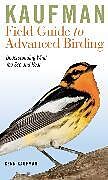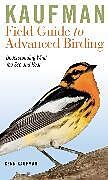Kaufman Field Guide to Advanced Birding
Einband:
Fester Einband
EAN:
9780547248325
Genre:
Nature, Gardening & Pets
Autor:
Kenn Kaufman
Herausgeber:
Houghton Mifflin Company
Erscheinungsdatum:
19.04.2011
Autorentext
KENN KAUFMAN, originator of the Kaufman Field Guide series, is one of the world’s foremost naturalists.
Klappentext
Birders can memorize hundreds of details and still not be able to identify birds if they don't really understand what's in front of them.Today birders have access to almost too much information, and their attempts to identify birds can be drowned out by excess detail. The all-new Kaufman Field Guide to Advanced Birding takes a different approach, clarifying the basics and providing a framework for learning about each group. Overall principles of identification are explained in clear language, and ten chapters on specific groups of birds show how these principles can be applied in practice. Anyone with a keen interest in identifying birds will find that this book makes the learning process more effective and enjoyable, and that truly understanding what we see and hear can make birding more fun.
Leseprobe
1. AN INTEGRATED APPROACH TO
FIELD IDENTIFICATION OF BIRDSIn the two decades since the first edition of Advanced Birding was published, the
amount of information available has increased by staggering amounts. In
the late 1980s, a serious birder’s reference library on ID would have included
Gulls: A Guide to Identification by P. J. Grant, Shorebirds: An Identification
Guide by Peter Hayman et al., and a handful of detailed articles from
British and American birding magazines. Today there are multiple fine
books specifically treating the identification of gulls, shorebirds,hawks,
hummingbirds, and any other group you can think of, and so
many fine articles have been published that it is impossible to keep
track of them all. In the late 1980s, Peter Pyle had just produced a first
slim guide to the molts and plumages of songbirds. Today that guide
has been superseded by two fat volumes by Pyle, totalling over 1,500
pages, detailing molt, plumage sequences, and geographic variation of
every North American bird. In the late 1980s an expert birder asked
me, in all seriousness, whether the Pomarine Jaeger even has a distinct
plumage as a juvenile. Today it takes a few clicks on the Internet to
find dozens of photos of this plumage, and many of these actually are
identified correctly! What had been a trickle of published material has
become a torrent. While the challenge formerly had been to find basic
information on identifying most birds, the challenge now is to sift
through the blizzards of information to find those points that are relevant,
significant, and reliable.
As times change, reference books and field guides must change also.
The first edition of Advanced Birding included detailed chapters on
identification of 34 species pairs or groups, providing information that
was not readily available to most birders. Simply updating that book
now without changing its focus would hardly serve a useful purpose,
because virtually all birders have access to vastly more information today
than they did in 1990.
If I were to simply list more and more field marks for more species,
this guide would take on the dimensions of an encyclopedia before it
added materially to what is already available. So in this edition I have
taken a different approach altogether, and the focus here is on how to
identify birds, or how to learn to identify birds. In other words, it’s not
about memorizing field marks, it’s about truly understanding what
you see and hear.
Most of this book, then, consists of a thorough exploration of how
to look at birds and how to listen to them, how to come to grips with
the special challenges of each group of birds. Unlike many field guides,
this one is not designed for quick reference in the field. The best time
to study it is before going out to look at birds. The first seven chapters
will help orient you to universal aspects of bird recognition. Then, if
you’re heading to the tidal flats or the sewage ponds, read the chapter
on learning to identify shorebirds. If you’re heading to a hawkwatch
site, read the chapter on learning to identify birds of prey. And so on.
In addition to all these introductory chapters, I have included ten
“sample” chapters treating specific groups in depth. These should be
useful in their own right, but they also illustrate various principles: the
challenges involved in identifying jaegers, for example, are very different
from those we encounter with Empidonax flycatchers. As you master
the identification of more groups of birds, you will develop the kind
of background knowledge that makes it easier to learn even more.SCHOOLS OF THOUGHT: IMPRESSIONS VS. FEATHER-EDGESSince the 1980s, the birding world has put a lot of discussion into two
distinct approaches to identification. One involves what is often called
“giss” (for “general impressions of size and shape”), or “birding by impression.”
The other involves a careful study of fine details, down to the
pattern of individual feathers (this may be referred to, sometimes with
a hint of sarcasm, as the “feather-edges” approach).
Both of these styles seem to be at least partly a reaction against the
system of simplistic field marks. Under that system, everything was reduced
to simple on-off characters: the bird has wing bars or doesn’t, it
has streaks below or doesn’t, and so on. That approach, ignoring both
the obvious aspects of shape and the subtle nuances of fine detail, led
to a lot of superficial identifications and a lot of potential for error.
Simple field marks hold many traps and pitfalls for the unwary. Both
of these other approaches, impressions and feather-edges, have their
drawbacks and their strengths, and a serious birder will work on developing
both.
Identifying birds by impression has been called “the new Cape May
school of birding,” which would be a surprise to the experts who were
practicing this approach in California in the 1960s or in Massachusetts
in the 1940s. Still, this style of ID has been raised to a higher level and
well publicized by several experts associated with Cape May, New Jersey,
especially Pete Dunne, Michael O’Brien, and Kevin Karlson.
Most people, even if they have not considered it, are already subconsciously
capable of using this approach. We may use it frequently
in other contexts. If we know a person well, we may recognize her from
half a mile away by subtle clues of posture or the way she walks. Likewise,
if we know a bird well, we may recognize it at a great distance by
almost subliminal hints of its shape and actions. An experienced birder
seeing a speck soaring slowly over a faraway ridge might identify it as a
Turkey Vulture without being able to discern a single detail. An experienced
birder seeing a flock of birds wheeling tightly in the air over a
distant mudflat might identify the birds as Dunlins, even without being
able to see anything of color or markings. In these cases, factors of
place, season, habitat, and probability are added to clues provided by
shape and actions to create an identification that seems almost intuitive
but in fact is based on real evidence.
Identifying birds by looking at fine detail is an approach that goes
back even further — to the days when most birds were identified in
the hand. Until the latter part of the 20th century, of course, such fine
points usually couldn’t be seen in the field, but optics today are so good
that we often can see details of individual feathers — either in the field,
or i…

Leider konnten wir für diesen Artikel keine Preise ermitteln ...
billigbuch.ch sucht jetzt für Sie die besten Angebote ...
Die aktuellen Verkaufspreise von 6 Onlineshops werden in Realtime abgefragt.
Sie können das gewünschte Produkt anschliessend direkt beim Anbieter Ihrer Wahl bestellen.
Loading...
Die aktuellen Verkaufspreise von 6 Onlineshops werden in Realtime abgefragt.
Sie können das gewünschte Produkt anschliessend direkt beim Anbieter Ihrer Wahl bestellen.
| # | Onlineshop | Preis CHF | Versand CHF | Total CHF | ||
|---|---|---|---|---|---|---|
| 1 | Seller | 0.00 | 0.00 | 0.00 |
